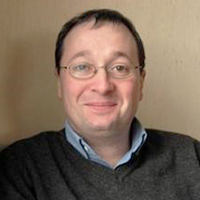By Poul G. Hjorth and Chris Breward
Since its origin at the University of Oxford in the late 1960s, a particularly creative type of workshop that involves industrial mathematics—which we loosely define here as the branch of applied math that focuses on problems with direct relevance to industry, charities, and/or government—has spread across the globe.
Workshops where mathematicians focus on current industrial problems—known as Mathematical Problems in Industry in the U.S. and European Study Groups with Industry in Europe—have become a popular format for collaborative applied mathematics across the globe. Photo courtesy of Poul Hjorth.
Known as
Mathematical Problems in Industry in the U.S., and as
European Study Groups with Industry in Europe, these workshops have similar formats. Representatives from several companies first present mathematical challenges to the applied mathematicians, who then split into smaller workgroups to address the challenges during the remaining days. Nobody presents their own academic work in the usual conference sense, as the event focuses entirely on the new problems from the participating companies.
The long-lived success of these study groups speaks to the concept’s remarkable win-win nature: industries have their problems “flash fried” and examined by a group of academic mathematicians, who get to use their methods and knowledge on real-world problems. Doctoral students often attend the workshops as well. The groups present their findings to the companies at the end of the meeting, after which they provide a report with calculations, algorithms, and so forth. These reports sometimes contain concepts and ideas that are publishable. In such cases, the reports evolve into research papers that eventually appear in a relevant journal like the SIAM Journal on Applied Mathematics. But even if a report is not immediately publishable because it “only” contains small variations of already known results or fairly straightforward modeling, it still has value in at least two separate ways.
First, it often happens that members of later study groups—sometimes several years down the road—face an industrial challenge that shares elements with a problem from a previous event. If someone recalls the earlier problem, the group may then wish to review the prior report. Participants may send frantic emails to the organizers of the previous study group, who might not be able to locate it.
Second, even if a report does not ultimately result in a peer-reviewed paper, it still represents a piece of concrete intellectual work that should be made available to future researchers. This is particularly true for early-career scientists, who need to document and cite their scientific productions.
The solution to the lack of curation for study group reports was the creation of a one-stop-shop repository. Oxford’s Mathematics in Industry Information Service (MIIS) initially hosted this repository, which addressed the issue of organization but did not make the work visible. As the need for a well-defined, searchable, and citable international web repository for study group reports grew, discussions between Oxford, Cambridge University Press (CUP), and the European Consortium for Mathematics in Industry (ECMI) resulted in an agreement to build Mathematics in Industry Reports (MIIR) on CUP's Cambridge Open Engage platform.
The homepage of Mathematics in Industry Reports (MIIR). The repository is searchable for the keywords that each report is required to list. The reports are formatted via a uniform LaTeX template and lightly moderated, but they not refereed since MIIR is a repository (not a journal). Each workshop pays a small fee to have their reports entered into MIIR.
MIIR launched in 2021 and featured some of the most historic and memorable reports from MIIS, courtesy of a financial contribution by ECMI. The repository is now fully operational. Industrial mathematics study groups from around the world are welcome to publish on the site, and a LaTeX template is available to ensure uniformity of format. CUP and a small international panel of moderators manage MIIR and oversee the content. The reports are not peer reviewed, but they are subject to checks from study group organizers and moderated by the MIIR Moderation Panel prior to posting. Once a report appears on MIIR, it is assigned a Digital Object Identifier for citation purposes. The titles and keywords are searchable, and users can post comments. To date, MIIR has received more than 25,000 abstract views and nearly 6,000 report downloads.
Feel free to check out the MIIR website if you are interested in browsing reports or contributing content. If you plan to organize a mathematical study group with industry and would like MIIR to host the resulting reports, please contact one of MIIR's chief moderators.
Further Reading
[1] Freitas, P. (2009, March 21). European study groups with industry at 40 years. SIAM News, 42(2), p. 4.
[2] Hjorth, P.G. (2017). Innovative and collaborative industrial mathematics in Europe. Proc. R. Soc. A, 473(2201).
[3] Ockendon, H. (2007, October 21). Mathematics-in-industry study groups – A global phenomenon. SIAM News, 40(8), p. 12.
[4] Rossi, L.F. (2010, April 1). Mathematical problems in industry workshop celebrates 25 years. SIAM News, 43(3), p.2.
 |
Poul G. Hjorth is an associate professor in the Department of Applied Mathematics and Computer Science at Technical University of Denmark, where he works on applied dynamical systems and industrial mathematics. He also currently serves as executive director of the European Consortium for Mathematics in Industry. |
 |
Chris Breward is an associate professor at the University of Oxford. He works on mathematical modelling across a wide variety of applications, including filtration, decontamination, and materials processing. Breward is also co-director of the EPSRC Centre for Doctoral Training in Industrially Focused Mathematical Modelling. |